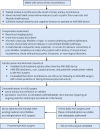The Asia-Pacific AMS800 artificial urinary sphincter consensus statement
- PMID: 36375037
- PMCID: PMC10100264
- DOI: 10.1111/iju.15083
The Asia-Pacific AMS800 artificial urinary sphincter consensus statement
Abstract
This Asia-Pacific (AP) AMS 800™ artificial urinary sphincter (AUS) consensus statement aims to provide a set of practical recommendations to assist surgeons with the AMS 800 device surgery. The AP consensus committee consisted of key opinion leaders with extensive experience with AMS 800 surgery across several AP countries. The panel reviewed and discussed relevant findings with emphasis on locoregional and specific clinical challenges relevant to the AP region. Recommendations were made in key areas namely (1) patient selection and informed consent process; (2) preoperative assessment; (3) dealing with co-existing urological disorders; (4) surgical principles and intraoperative troubleshooting; (5) postoperative care; (6) special populations; and (7) cost analysis and comparative review. The AMS 800 device should be offered to males with moderate to severe stress urinary incontinence (SUI). Full informed consent should be undertaken, and emphasis is placed on surgical contraindications and high-risk candidates. The presence of a surgical mentor or referral to experts is recommended in complex AUS candidates. Preoperative cystoscopy with or without multichannel urodynamic study is necessary and patients with pre-existing urological disorders should be treated adequately and clinically stable before surgery. Adherence to strict patient selection and safe surgical principles are critical to ensure excellent clinical outcomes and minimize complications. Given that InhibiZone-coated device is not available in many AP countries, the use of prophylactic antibiotics pre-and post-operatively are recommended. The AMS 800 device should be prepared according to the manufacturer's guidelines and remains a cost-effective treatment for male SUI. The AMS 800 device remains the surgical benchmark for male SUI but is associated with certain mechanical limitations and a unique set of complications.
Keywords: artificial urinary sphincter; assessment; complications; special populations; urinary incontinence.
© 2022 The Authors. International Journal of Urology published by John Wiley & Sons Australia, Ltd on behalf of The Japanese Urological Association.
Conflict of interest statement
None declared.
Figures
References
-
- Scott FB, Bradley WE, Tim GW. Treatment of urinary incontinence by an implantable prosthetic urinary sphincter. J Urol. 1974;112(1):75–80. - PubMed
-
- Chung E. A state of art review on the evolution of the urinary sphincter devices for the treatment of post‐prostatectomy urinary incontinence: past, present and future innovations. J Med Eng Technol. 2014;38(6):328–32. - PubMed
Publication types
MeSH terms
Grants and funding
LinkOut - more resources
Full Text Sources
Medical


